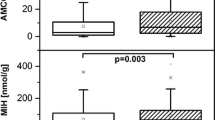AbstractObjective:
In a factory producing synthetic fibers the hepatotoxic effects of the solvent N,N-dimethylformamide (DMF) were investigated in 126 male employees, especially with regard to the combination effects of DMF exposure and ethyl alcohol consumption. A collective of similar structure from the same factory served as a control collective. Methods: Reference is made to the results of air measurements and biological monitoring presented in a previous publication. The DMF concentrations in the air ranged from <0.1 (detection limit) to 37.9 ppm (median 1.2 ppm). Concentrations of the DMF metabolite N-methylformamide (NMF) in urine were 0.05–22.0 mg/l (preshift) and 0.9–100.0 mg/l (postshift), corresponding to 0.02–44.6 mg/g creatinine (preshift) and 0.4–62.3 mg/g creatinine (postshift). A standardized anamnesis was drawn up for relevant previous illnesses and other factors influencing liver function. The laboratory tests included parameters especially relevant to the liver (e.g., AST, ALT, γ-GT, hepatitis B and C antibodies, and carbohydrate-deficient transferrin). Results: The results indicate a statistically significant toxic influence of DMF on liver function. Alcohol has a synergistic effect. The effects of DMF and those of alcohol are dose-dependent. Under the existing workplace conditions the hepatotoxic effects of alcohol are more severe than those of DMF. In the exposed group there was a statistically significantly greater number of persons who stated that they had drunk less since the beginning of exposure (13% versus 0). This corresponded with the data on symptoms occurring after alcohol consumption (71% versus 4%). In the work areas with lower-level exposure to DMF there was greater alcohol consumption. It corresponded to that of the control collective not exposed to DMF. Conclusion: In this study we tried to differentiate and quantify the interaction between DMF exposure and alcohol consumption and the influence of both substances on liver function. The experience gained from former occupational health surveillance in DMF-exposed persons and from the present study show that there are individual differences in tolerance of interactions between DMF and ethyl alcohol. Further studies are necessary for the evaluation of these individual degrees of susceptibilitiy.
Similar content being viewed by others
Author information
Authors and Affiliations
Additional information
Received: 23 February 1998 / Accepted: 19 August 1998
Rights and permissions
About this article
Cite this article
Wrbitzky, R. Liver function in workers exposed to N,N-dimethylformamide during the production of synthetic textiles. Int Arch Occup Environ Health 72, 19–25 (1999). https://doi.org/10.1007/s004200050329
Issue Date:
DOI: https://doi.org/10.1007/s004200050329




